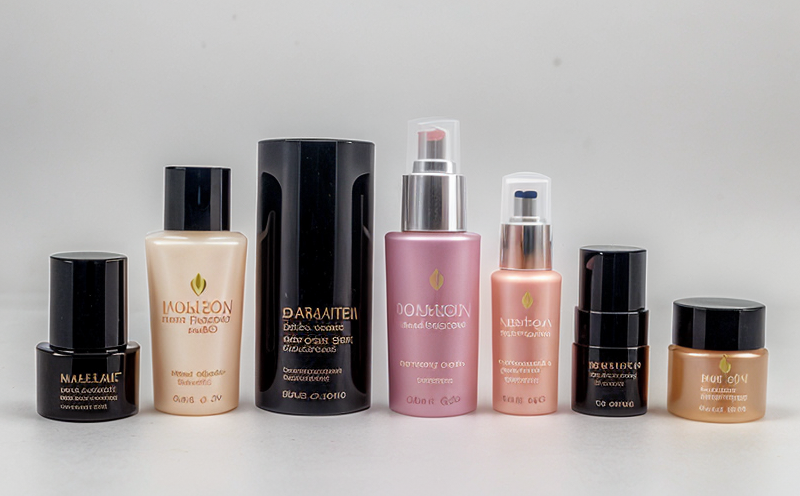Tube Packaging Migration Testing in Cosmetic Products
The testing of tube packaging migration in cosmetic products is a critical aspect of ensuring product safety and compliance with regulations. This process involves the evaluation of how materials used in the packaging interact with the contents they contain, particularly focusing on the transfer of substances from the container to the product inside.
Tube packaging, such as those made of plastics or metals, can potentially release components like antioxidants, pigments, or preservatives into cosmetic formulations. These interactions are monitored during migration testing to ensure that no harmful levels of these materials reach consumers through their skincare products. The tests aim to detect any leachable substances and determine if they fall within acceptable limits set by regulatory bodies.
The process typically begins with selecting appropriate specimens for analysis, which includes both the cosmetic product itself as well as the packaging material used in its formulation. Samples are prepared according to specific protocols outlined in international standards such as ISO 17519-2:2014 or ASTM E2846-13. These guidelines provide detailed procedures for sample preparation, extraction methods, and analytical techniques.
After preparing the samples, they undergo rigorous testing using advanced instrumentation like gas chromatography-mass spectrometry (GC-MS) or high-performance liquid chromatography (HPLC). The chosen method depends on the type of packaging being tested (e.g., plastic, metal), as different materials require specialized extraction processes. For instance, polyethylene terephthalate (PET) bottles would use a different approach compared to aluminum tubes.
The results from these analyses are then carefully evaluated against established limits for specific contaminants. Regulatory thresholds like those found in the European Union's Cosmetic Regulation (EC No 1223/2009) or FDA guidelines must be adhered to ensure compliance with global standards. If any migrating compounds exceed allowable levels, further investigation into the source and potential mitigation strategies is necessary.
Compliance officers responsible for quality assurance in cosmetic manufacturing should understand that thorough tube packaging migration testing plays a crucial role in maintaining consumer trust and protecting brand reputation. By adhering to strict protocols and leveraging state-of-the-art analytical tools, laboratories can provide reliable data essential for making informed decisions about product safety.
Understanding the complexities involved in this type of testing helps stakeholders appreciate its importance beyond mere regulatory compliance. It serves as a vital step towards safeguarding public health while fostering innovation within the industry by identifying safe alternatives and improving existing formulations without compromising effectiveness or appearance.
Why It Matters
Migrating substances from tube packaging into cosmetic products can pose significant risks to human health if not properly managed. Consumers expect their beauty and personal care items to be free from harmful chemicals, especially those that might be absorbed through skin contact or ingestion during use.
Regulatory frameworks around the world emphasize the need for thorough evaluation of package-to-product interactions as part of overall cosmetic safety assessments. For instance, in the EU, Directive 2013/56/EU requires manufacturers to demonstrate that all materials and components used in packaging do not release substances at concentrations exceeding specified limits.
Failure to adequately address migration issues could lead to legal repercussions, including fines or product recalls, which can severely impact a company's reputation and financial standing. Moreover, non-compliance may result in lost market share due to reduced consumer confidence and trust in the brand.
On a broader scale, ensuring rigorous testing practices supports sustainable development goals by promoting safer alternatives for packaging materials that minimize environmental impacts while maintaining functionality and safety standards.
Quality and Reliability Assurance
Ensuring high-quality outputs from tube packaging migration tests is essential not only for regulatory compliance but also for building strong brands trusted by consumers. Quality assurance in this context involves several key steps:
- Standardized Sample Preparation: Adherence to internationally recognized protocols ensures consistent results across different laboratories.
- Reproducibility: Repeated tests should yield similar outcomes, indicating reliable methods and equipment.
- Data Validation: Cross-referencing findings with other relevant studies enhances credibility of the test results.
- Continuous Improvement: Regular reviews of testing procedures allow for updates based on new knowledge or technological advancements.
Incorporating these practices into routine operations helps maintain consistent standards, thereby fostering customer satisfaction and loyalty. It also positions companies as leaders in innovation by continuously pushing boundaries to develop safer products without compromising performance.
International Acceptance and Recognition
Migrating substances from tube packaging into cosmetic products is a global concern, and various international organizations have established guidelines and standards to address this issue. Regulatory bodies like the European Union (EU), United States Food and Drug Administration (FDA), and World Health Organization (WHO) play pivotal roles in setting limits for acceptable levels of migration.
In the EU, Directive 2013/56/EU mandates that all materials and components used in packaging must not release substances at concentrations exceeding specific thresholds. This directive emphasizes the importance of thorough evaluation of package-to-product interactions to ensure consumer safety. Similarly, FDA regulations require manufacturers to provide evidence demonstrating that their products comply with applicable standards.
Recognition from these bodies adds value by signaling adherence to stringent quality control measures and enhancing credibility among consumers. Brands that meet international requirements not only avoid potential legal issues but also gain a competitive edge in the global market. By adhering strictly to established protocols, companies demonstrate their commitment to maintaining high standards of product safety and integrity.





